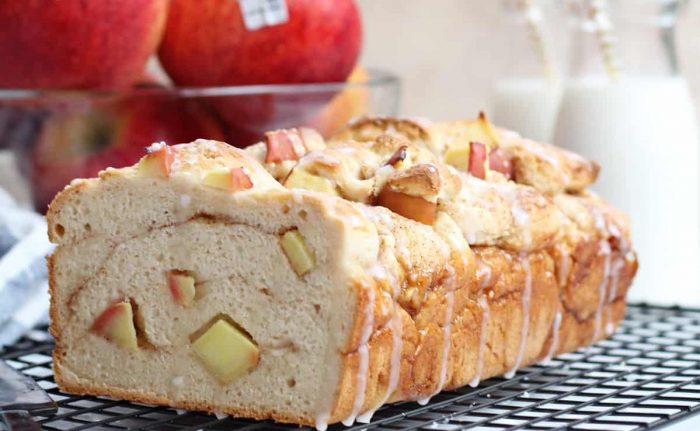By Heidi Sutton
The weather is starting to cool down and what better way to warm up than with a comforting homemade bread?
Apple Cinnamon Pull-Apart Bread
Recipe courtesy of Envy Apples

If you are looking for the perfect apple breakfast or dessert then you should try this apple pull apart bread. This version is gluten free, with less fat and calories than most of the other versions.
YIELD: Makes 8 servings
INGREDIENTS:
Dough
3 cups gluten free bread flour
1 1/4 cup whole milk or milk of choice
2 1/4 teaspoon rapid yeast 1 packet
1/4 cup water
3 teaspoons xanthan or guar gum
1/2 teaspoon salt
1/2 cup sugar
2 tablespoons softened coconut oil
Olive oil spray
Filling
2 large apples cut into bite-size pieces
1/4 cup brown sugar
2 teaspoons cinnamon
Glaze (optional)
1/2 cup powdered sugar
2 teaspoons water
DIRECTIONS:
Heat ¼ cup of water to 100 degrees. Add yeast and set aside about 30 minutes until foaming. Mix all dry ingredients for the dough. Combine yeast, coconut oil and milk. Vigorously mix ingredients by hand for 10 minutes or stand mixer for 5 minutes to help activate gum. Cover bowl and let dough rest for 10 minutes.
Wash and dice apples. *peel if desired. Set aside until needed. Lightly spray a sheet of parchment paper the size of a baking sheet. Place dough on the parchment paper. Spray dough with olive oil spray. With greased hands, gently press out dough to form a rectangle approximately 12×16 inches. Sprinkle cinnamon and brown sugar over dough. Slice dough into 5-6 equal rows lengthwise (right to left) and 3-4 equal columns width wise (top to bottom).
Spray a 9 x 5 inch bread pan with olive oil spray. Carefully move a dough square into bread pan, filling the bottom of the pan. Sprinkle with apple bites. Make another layer. Take squares of dough and make another later. Sprinkle with apple bites. Continue until you have used all (or most of) the dough and as much apple pieces as you would like. *Don’t over stuff though, the dough will need to rise. Cover with plastic and allow bread to rest for 20 minutes. Bake at 375 degrees for 30-35 minutes or until top turns golden brown. Remove from oven and allow to sit in the pan to steam another 10 minutes.
Make glaze by mixing powdered sugar and water until desired consistency. Drizzle over bread before serving.
Healthier Pumpkin Banana Bread
Recipe courtesy of Cookin’ Savvy

This recipe is sure to become a staple in your household this fall! Full of comforting, good-for-you ingredients and delicious fall flavors, serve warm and smother with nut butter for a tasty snack or breakfast! It’s also freezer-friendly so you can pull out individual servings to reheat as needed for the future. Sprinkle some nuts and dark chocolate chips on top, and the whole family is sure to love it.
YIELD: Makes 8 servings
INGREDIENTS:
Nonstick cooking spray
2 ripe bananas,mashed,
1 cup pumpkin puree
1/4 cup Greek yogurt,plain or vanilla
2 eggs
1/2 cup unsweetened applesauce
2 cups whole-wheat flour
1/2 cup old-fashioned oats
1/4 cup granulated sugar
1 teaspoon baking powder
1/2 teaspoon baking soda
1/2 teaspoon salt
1/2 teaspoon nutmeg
1/2 teaspoon ginger
1 teaspoon cinnamon
1/4 cup dark chocolate chips, plus additional, for topping
1/4 cup chopped walnuts or nuts of choice, plus additional, for topping
pumpkin spice granola, for topping
DIRECTIONS:
Preheat oven to 350 F. Spray loaf pan with nonstick cooking spray. In large bowl, whisk mashed bananas, pumpkin puree, Greek yogurt, eggs and applesauce. Set aside.
In medium bowl, use large spoon to stir flour, oats, sugar, baking powder, baking soda, salt, nutmeg, ginger and cinnamon. Add flour mixture to banana and pumpkin mixture; whisk until just moist. Stir in dark chocolate chips and walnuts, if desired.
Pour batter into loaf pan. Sprinkle granola and additional chocolate chips and walnuts on top, if desired. Bake 50-60 minutes, or until knife inserted comes out clean.





















